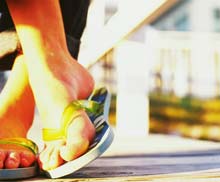Low Vitamin D Levels Pose “Large Threat to Health” …
Are You Absorbing Enough?
by www.SixWise.com
In what is being called the “most conclusive evidence to date,” a study by Johns Hopkins researchers found that low levels of vitamin D lead to a significantly increased risk of death. The study, published in the Archives of Internal Medicine, included a large, diverse sample of 13,000 men and women.
|

Have low levels of vitamin D, the “sunshine” vitamin, may increase your risk of death by 26 percent!
|
Researchers compared the risk of death between those with the lowest vitamin D levels and those with higher levels. During the course of the study, 1,800 people died, nearly 700 of which died from heart disease. Among them, 400 were deficient in vitamin D.
This data, researchers said, translates into a 26 percent increased risk of death from low vitamin D levels.
"Our results make it much more clear that all men and women concerned about their overall health should more closely monitor their blood levels of vitamin D, and make sure they have enough," study co-lead investigator Erin Michos, M.D., M.H.S. told ScienceDaily.
"We think we have additional evidence to consider adding vitamin D deficiency as a distinct and separate risk factor for death from cardiovascular disease, putting it alongside much better known and understood risk factors, such as age, gender, family history, smoking, high blood cholesterol levels, high blood pressure, lack of exercise, obesity and diabetes," he continued.
Insufficient Vitamin D Linked to Heart Disease
Researchers at the University of Colorado Denver and Massachusetts General Hospital evaluated the association between vitamin D levels and death rates of those 65 and older and found the vitamin plays a vital role in reducing risk of death associated with older age.
Specifically, older adults with insufficient levels of vitamin D are more likely to die from heart disease and other causes than those with adequate levels. Those with low vitamin D levels were three times more likely to die from heart disease -- and 2.5 times more likely to die from any cause -- than those with optimal vitamin D.
"It's likely that more than one-third of older adults now have vitamin D levels associated with higher risks of death and few have levels associated with optimum survival," Adit Ginde, MD, MPH, an assistant professor at the University of Colorado Denver School of Medicine's Division of Emergency Medicine and lead author of the study, told ScienceDaily. "Given the aging population and the simplicity of increasing a person's level of vitamin D, a small improvement in death rates could have a substantial impact on public health."
Why Vitamin D is About So Much More Than Just Your Bones
It’s long been said you need to have vitamin D to keep your bones healthy, but vitamin D is important for much more than that.
Vitamin D, which is actually not a vitamin but a secosteroid hormone, targets over 2,000 genes in your body; this is about 10 percent of the entire human genome! According to the Vitamin D Council:
"Current research has implicated vitamin D deficiency as a major factor in the pathology of at least 17 varieties of cancer as well as heart disease, stroke, hypertension, autoimmune diseases, diabetes, depression, chronic pain, osteoarthritis, osteoporosis, muscle weakness, muscle wasting, birth defects, periodontal disease, and more.”
Many People are Deficient
Because many people no longer spend much time in the sun without sunblock (sunblock blocks vitamin D production) vitamin D deficiency is thought to be very widespread. The elderly are especially at risk of deficiency because of:
-
Limited time spent in the sun (even people living in warm, sunny climates are often vitamin-D deficient because they either spend much of their time indoors, wear sunscreen when in the sun (this blocks vitamin D production) or they are only outside during non-peak hours when the sun’s vitamin-D-producing rays are not as strong.
-
A reduced ability to make vitamin D, which occurs as we age
- Inability to absorb vitamin D in supplements and from the sun. Vitamin D is an oil-soluble steroid hormone and, according to Dr. Joseph Mercola it can take 48 hours for the vitamin D that forms on your skin after sun exposure to become absorbed by your body. If you shower with soap and water before this time, you’ll wash much of the vitamin D away.
To avoid this, you can avoid using soap on all but the crucial areas of your body for up to two days after sun exposure (avoid soaping the larger areas of your body and just use soap under your arms and your groin area, etc.).
-
Further, because vitamin D is oil-soluble it is difficult to absorb in supplement form as well. So if you take a vitamin D3 supplement you will want to take it in an oil-based form, and also make sure you use AbsorbAid Platinum from NutritionsFinest.com, a vegetable-based digestive enzyme, as a transfer agent, as it will aid in the breakdown and absorption of vitamin D (both from supplements and from foods).
The majority of U.S. kids, about 70 percent in all, have low levels of vitamin D as well, according to data collected on more than 6,000 children ages 1-21.
How to Increase Your Vitamin D Levels
Vitamin D experts now believe the minimal acceptable level for vitamin D is 50 ng/ml. The Vitamin D Council explains:
"They [vitamin D researchers] found that the body does not reliably begin storing cholecalciferol in fat and muscle tissue until 25(OH)D levels get above 50 ng/ml. The average person starts to store cholecalciferol at 40 ng/ml, but at 50 ng/ml virtually everyone begins to store it for future use. That is, at levels below 50 ng/ml, the body uses up vitamin D as fast as you can make it, or take it, indicating chronic substrate starvation -- not a good thing. 25(OH)D levels should be between 50–80 ng/ml, year-round."
A blood test from your doctor, called the 25-hydroxyvitamin D, can determine whether your vitamin D levels are high enough, but you should know that typical laboratory reference ranges may indicate a lower level of vitamin D as “healthy,” when newer research has shown the minimal acceptable level for vitamin D to be 50 ng/ml.
If you find your levels are low, you may need to take a vitamin D supplement. According to the Vitamin D Council:
“If well adults and adolescents regularly avoid sunlight exposure, research indicates a necessity to supplement with at least 5,000 units (IU) of vitamin D daily. To obtain this amount from milk one would need to consume 50 glasses. With a multivitamin more than 10 tablets would be necessary. Neither is advisable.
The skin produces approximately 10,000 IU vitamin D in response 20-30 minutes summer sun exposure -- 50 times more than the US government's recommendation of 200 IU per day!”
|
Enhance Your Body’s Absorption of Vitamin D With AbsorbAid Platinum

Vitamin D is meant to be made in your skin after sun exposure, and is not typically well absorbed in supplement form. But because many people do not have access to sunshine year-round, supplementation is often necessary to keep your vitamin D levels in the optimal range.
Nature’s Sources AbsorbAid Platinum, a vegetable-based digestive enzyme, helps you to break down food groups and maximize nutrient absorption, so your body is able to better absorb vitamin D in supplement form.
AbsorbAid Platinum will aid the breakdown and absorption of vitamin D present in foods such as fortified cereals, milk, juices, and oily fish, as well as the vitamin D in supplement form.
|
The Vitamin D Council continues:
“There are 3 ways for adults to ensure adequate levels of vitamin D:
-
Regularly receive midday sun exposure in the late spring, summer, and early fall, exposing as much of the skin as possible.
-
Regularly use a sun bed (avoiding sunburn) during the colder months.
-
Take 5,000 IU per day for three months, then obtain a 25-hydroxyvitamin D test. Adjust your dosage so that blood levels are between 50–80 ng/mL (or 125–200 nM/L) year-round.”
If You Take a Vitamin D Supplement, Make Sure It’s Being Absorbed
Sun exposure is the best form of vitamin D, but if you cannot get out in the sun regularly, experts recommend supplementing with a vitamin D3 supplement, which is the same natural vitamin D your body makes when exposed to the sun. Avoid vitamin D2, which is synthetic and may be less safe and less effective.
Along with regularly testing your blood levels of vitamin D to make sure you’re in the optimal range -- not too high or too low -- you should make sure your body has the best chances of absorbing the vitamin D.
Because vitamin D is an oil-soluble vitamin meant to be made by your skin, it is not well absorbed. So you will want to take it in an oil-based form, and also make sure you use AbsorbAid Platinum from NutritionsFinest.com, a vegetable-based digestive enzyme, as a transfer agent. AbsorbAid Platinum will aid the breakdown and absorption of vitamin D present in foods such as fortified cereals, milk, juices, and oily fish, as well as the vitamin D in supplement form.
AbsorbAid Platinum combines its effective ratio of proteases, amylases, lipases and cellulases with two "acid-tolerant" bacteria or a probiotic combination, Lactobacillus acidophilus and Bifidobacterium bifidum to help you break down food groups and maximize nutrient absorption.
Optimizing your vitamin D levels, it turns out, could very well be one of the most important steps you take for your health. As the Vitamin D council says:
“Vitamin D's influence on key biological functions vital to one's health and well-being mandates that vitamin D no longer be ignored by the health care industry nor by individuals striving to achieve and maintain a greater state of health.”
Recommended Reading
Recommended Reading
Lack of Vitamin D in U.S. Kids “Shocking”
What Essential Vitamin Can Lower Your Risk of Dying as You Age (Especially as You Approach 65 and Beyond)?
Sources
Archives of Internal Medicine 2008 Aug 11;168(15):1629-37.
Journal of the American Geriatrics Society June 22, 2009
The Vitamin D Council
Mercola.com May 12, 2009
ScienceDaily.com September 22, 2009
Science Daily.com August 12, 2008